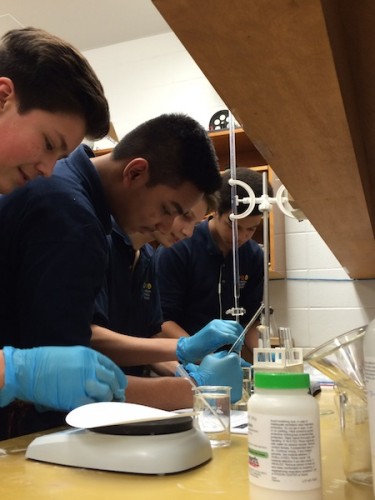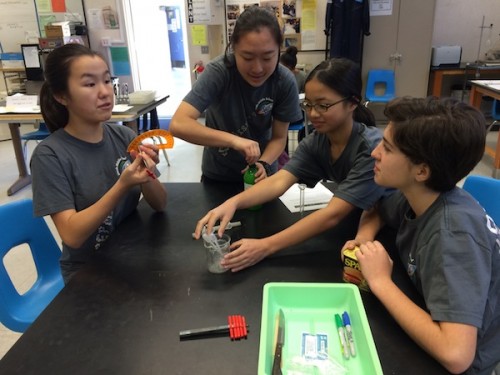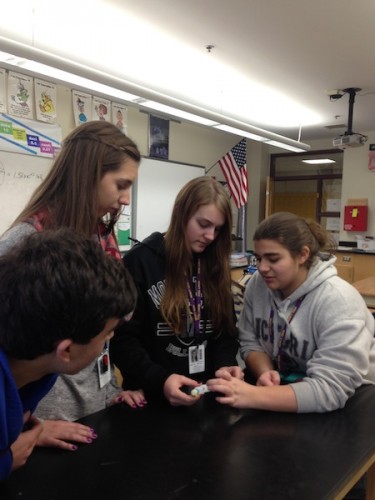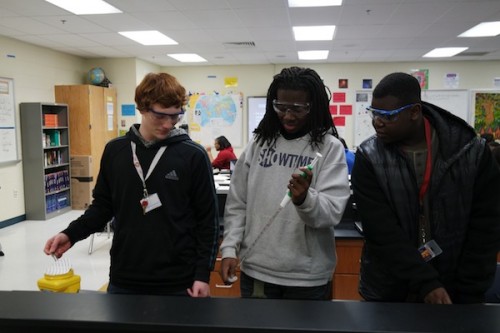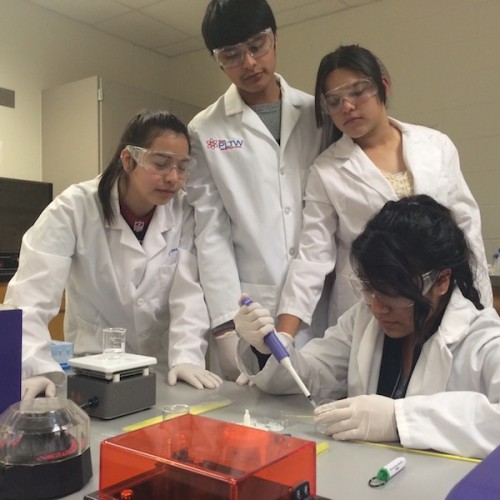The Student Spaceflight Experiments Program is proud to report that there were a total of 2,466 proposals submitted from student teams across the 21 communities participating in Mission 9 to ISS. Of those, 909 proposals were forwarded for review by Step 1 Review Boards in each of the communities. Each Step 1 Review Board selected three finalist proposals, which were submitted to the National SSEP Step 2 Review Board.
On December 7 and 9, 2015, the Step 2 Review Board met at the Smithsonian National Air and Space Museum, reviewed all 63 finalist proposals, and selected one proposal to fly for each community, for a total of 21 flight experiments. By December 17, 2015, the National Center for Earth and Space Science Education and the Arthur C. Clarke Institute for Space Education formally notified each community of their selected flight experiments.
It is noteworthy that the 2,466 proposals received reflected a total of 11,890 grade 5-12 students fully engaged in experiment design.
All 63 finalist experiment teams, along with descriptions of their proposed flight experiments, are provided below. You are also invited to meet the SSEP Step 2 Review Board members for Mission 9 to ISS.
Congratulations to the nearly 12,000 students and their teachers participating in Student Spaceflight Experiments Program Mission 9 to the International Space Station.
Quickly Scroll to Individual Communities
- Calgary, Alberta, Canada – Langevin School
- Vancouver, British Columbia, Canada
- Santa Monica, California
- East Lyme, Connecticut
- Hillsborough County, Florida
- Boise, Idaho
- Potomac, Maryland
- Fitchburg, Massachusetts
- Traverse City, Michigan
- Jersey City, New Jersey
- Springfield, New Jersey
- Buffalo/Niagara, New York
- Eugene, Oregon
- Columbia, South Carolina
- North Charleston, South Carolina
- Knox County, Tennessee
- Bullard, Texas
- Burleson, Texas
- Houston, Texas
- McAllen, Texas
- Bellevue, Washington
1. Calgary, Alberta, Canada – Langevin School
Jump to Calgary’s Community Profile
SELECTED FOR FLIGHT:
Shells of Glass Capsules, Covered with Different Substances Reacting in Regular
Water
Grade 9, Langevin Science School, Calgary Board of Education
Co-Principal Investigators: Metro Anderson, Safo Arthur, Arnav Jain, Tatum Parker
Teacher Facilitator: Shane Turner
Proposal Summary:
The main aim of our project is to observe how three different capsule shells, covered in corn starch (Carbohydrates), gum Arabic (Gum) and sucrose (Carbohydrates) dissolve in regular water, in addition to the reaction and release rate in a microgravity environment. Our background
research has stated that these substances will dissolve in water, but some may just settle at the bottom if let to sit for a certain amount of time. Certain coatings may react “faster” and ”slower” from lack of gravity but apart from that, we predict that starch will not be completely dissolved; gum Arabic will dissolve at all and sucrose will dissolve. The project will also consist of an acrylate, sodium polyacrylate. Sodium polyacrylate will stop the test sodium polyacrylate will absorb many times its size and form a polymeric gel. We are halting the dissolving process as we need to examine the results of the reaction of only sixty seconds. After the test is completed aboard the ISS, we will observe which substances can be completely dissolved, which can’t be dissolved at all or which were approaching their dissolving point. Once we have acquired this knowledge, future astronauts can be sent encapsulated medication with a certain substance covering the outer shell for more effective treatment. Knowing the differences may improve how a medication is produced and delivered into space. Medicine can also be improved on Earth by prolonging realise rate, and will make pills not needed as often.
HONORABLE MENTION FINALISTS:
Allergenic Proteins in Space – Where No One Can Hear You Wheeze!
Grade 8, Langevin Science School, Calgary Board of Education
Co-Principal Investigators: Benjamin Beaudry, Maxwell Couture
Teacher Facilitator: Mr. de Jong
Proposal Summary:
Do you ever wonder whether allergies are worsened or lessened in space? The answer
will be vital when long-term space travel becomes a reality. Allergies are caused by the immune
system’s response to allergenic proteins. It is already known that microgravity changes multiple
aspects of the immune system and yet there is no research regarding allergenic proteins in
microgravity. Therefore NASA has no idea how allergenic proteins are affected is space. This
leads to our specific question, “Will an allergenic protein change in microgravity?” A change
within an allergenic protein could mean a change in the severity of an allergic reaction. Thus, our
secondary question, “Will these structural changes alter the immune response?” It has been
documented that microgravity can alter the function of the immune system, both during and after
space flight. The immune system is key in causing allergy symptoms, it is unknown what effect
microgravity can have on one’s allergenic symptoms. Some evidence already shows that proteins
may be changed in space. The allergenic protein that will be tested upon will be Can f 1, this
protein is responsible for 70% of dog allergies and it has a well-known crystal structure. How
our experiment will be performed is simple, our group will send the Can f 1 protein into space
and analyze it using circular dichroism to find any change between it and the allergenic protein
currently on earth. These results will provide integral information in the field of allergenic
response in space and on earth.
The Effects of Vermicomposting in Microgravity
Grades 8, Langevin Science School, Calgary Board of Education
Co-Principal Investigators: Natalie Coulombe, Olivia Kelly
Teacher Facilitator: Gemma Epp
Proposal Summary:
Can Eisenia fetida worms survive in microgravity and does microgravity affect the speed at which they compost? Our experiment involves compost and Eisenia fetida worms to see how the worms react to microgravity. Eisenia fetida worms are essential to accelerating the composting process on Earth. This experiment includes seeing if the Eisenia fetida worms will survive in microgravity with the added bonus of discovering if microgravity impacts the speed at which the Eisenia fetida worms compost. Conducting these two experiments in one will be more cost effective and efficient. This experiment is important because compost can be used for gardening and is a reusable alternative to garbage. If we are to one day live in space, we need to be able to compost efficiently. This experiment will be conducted in a confined space that is 170mm in length and 13 mm in diameter so a small Eisenia fetida worm will be used. The biodegradable materials that will be included in the experiment are manure, clovers, melons, maple leaves and soil. When our experiment is completed in space, we will compare it to the same experiment done on Earth to see if the When our experiment is completed in space, we will compare the results from the test done on earth and carefully analyze similarities and differences from the different tests. we will compare the rate the worm decomposes materials and if they’re more or less broken down compared to the test done on Earth.
2. Vancouver, British Columbia, Canada
Jump to Vancouver’s Community Profile
SELECTED FOR FLIGHT:
Red Worm Composting In Microgravity
Grade 6-7, Westcot Elementary School, West Vancouver School District 45
Co-Principal Investigators: Griffin Edward, Vesal Farahi, Shania Farbehi, Kristopher Kirkwood, Joseph Piovesan
Advisors: Rick Adam, Dr. Leigh Palmer
Teacher Facilitator: Matt Trask
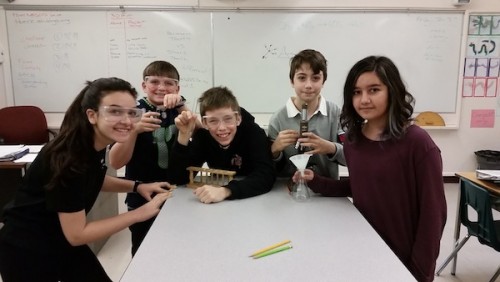
Vesal Farahi, Joseph Piovesan, Kris Kirkwood, Griffin Edwards and Shania Farbehi get ready to run more tests on worm cocoons to determine their optimal growing conditions.
Proposal Summary:
Our group proposes to send red worms into space with the aim of gaining important scientific knowledge that could lead to benefits for future space travel. On August 10, 2015, astronauts aboard the ISS harvested and ate romaine lettuce they planted in July. Red worms eat plants scraps and then excrete nutrients helping newer plants grow. This is called composting. As Patrick Cartwright said, there are many factors associated with composting: “Worms, however, are the real heroes of composting.” If we send our project into space, we will determine how red worms grow and function in microgravity. Astronauts lose their bone and muscle mass while in microgravity. Red worms have no bones but they do use muscles to burrow through dirt. We want to know whether or not red worms would be able to burrow in microgravity. Red worms are also a very important part of composting toilets. Composting toilets separates feces from other waste into a giant metal canister. Inside the canister, red worms then turn the waste into fertile soil that could be used to grow food. If red worms can grow in space, we could potentially have a fully functioning space garden with soil composted by the worms from the fecal waste produced by astronauts. Red worms in space would save the cost of transporting food into space because astronauts could grow their own food. As well, red worms could eliminate the cost of the waste capsules that are currently being used to dispose of human waste.
HONORABLE MENTION FINALISTS:
Seed Germination in Space
Grade 7, Caulfeild Elementary School, West Vancouver School District 45
Co-Principal Investigators: Elissa Caetano, Clara Chalmers, Jennifer Gu, Marisa van der Horts
Collaborators: Selena Brind-boronkay, Alex Caetano, Emma Shuparski
Teacher Facilitator: Martin Andrews
Proposal Summary:
Our experiment incorporates the germination of a green-coloured plant, called Sweet peas. Its
edibility is what convinces us that our highly- developed project should be the winning
individual that receives a position upon Mission 9. We wish to become a minor influence over
the development of plant growth in space, and we’re confident that our two seeds will
germinate exceptionally in micro-gravity. This belief has sparked because of a chemical called
Gibberellic acid (C19H22O6), which is stored in the left volume of our FME. The formula, when
purified, will be expected to encourage plants to grow rapidly and extensively, with protection
against frost. Our ambitions consist of quick seed germination, then preservation, and a helpful
note for scientific research involving plant growth in microgravity. When investigating, it was
found that our chemical may be the only essential our seed requires to germinate. Apparently,
sunlight and the nutrients from soil are not a necessity in the first days or weeks our plants are
growing in space. Astronauts, as we have gathered from research, aim for greenery to sprout
and flourish away from their natural habitat on earth. This would improve astronaut’s diets up
in space and also aid human settlement on Mars. Once our seeds have been germinated,
another chemical, formaldehyde, that occupies the right volume of our tube, will be combined
to the progressing experiment. Formaldehyde will preserve our seeds and will there-forth halt
the growth, hopefully helping the wonders of space associated science.
The Production of Synthetic Human Growth Hormone in Microgravity by Escherichia Coli
Grade 7, Ecole Cedardale Elementary School, West Vancouver School District 45
Co-Principal Investigators: Avalon Bryan, Irma Barath, Mikaela Milic
Teacher Facilitator: Kristina Hayes
Proposal Summary:
Currently, any individual who hopes to take part in a long-term spaceflight program will
eventually experience physiological symptoms of prolonged exposure to microgravity that could
negatively impact their performance-be it through their athletic performance or their cognitive
ability. We hope to address this issue through genetic engineering. Through a simple
recombinant process, we can successfully manufacture synthetic human growth hormone with
the use of transgenic E. coli. This method has been used to successfully manufacture HGH in
laboratories through the insertion of the gene into plasmids for over two decades.
We aim to perform this procedure in a microgravity environment in order to form a
definitive method through which HGH can be consistently synthesized in a microgravity
environment. Our proposed experiment has the potential to provide a suitable way to stay in a
microgravity environment for prolonged periods of time. If we succeed in manufacturing HGH
consistently on the ISS, one would be less likely to succumb to such spaceflight induced
symptoms as muscular and skeletal atrophy. One would consequently be capable of maintaining
a healthy physiology without significant adverse effects. We will activate freeze-dried transgenic E. coli samples (with recombinant plasmids for HGH) using lysogeny broth. Ideally, the E. coli bacteria will transcribe the human growth hormone gene to supply synthetic HGH. Further production will be stunted using preventative antibiotics so that the bacteria remain stagnant during descent and later observation. Upon return to Earth, we will detect HGH production through blotting techniques.
3. Santa Monica, California
Jump to Santa Monica’s Community Profile
SELECTED FOR FLIGHT:
The Effect of Microgravity on Preservation of Spam Using Lemon Juice
Grade 8, Lincoln Middle School, Santa Monica Malibu Unified School District
Co-Principal Investigators: Gina Kim, Thatcher Lee, Roxy Ong, Sydney Sobel
Collaborator: Anthony Bvlgari
Teacher Facilitators: Gretchen Gies-McLaunghlin and Carol Wrabel
Proposal Summary:
Considering the numerous restrictions, food storage has often been a predicament for space travel. The purpose of this experiment is to provide insight into more nutritious yet effective methods of food preservation. For this experiment, we will preserve a 7.5 cm x 0.8 cm x 0.8 cm block of “Classic Spam” with 4. mL of Lisbon lemon juice (citric acid). The question to be addressed is whether the preservation of spam in microgravity with citric acid, as measured by bacterial growth, differs compared to Earth. While the experiment is conducted aboard the International Space Station, the control experiment will be carried out on Earth. Once the FME returns from orbit, both samples will be compared to evaluate our hypothesis that in microgravity the growth of bacterial colonies will decrease (NASA). The goal of this experiment is to contribute ideas for food storage aboard the International Space Station.
HONORABLE MENTION FINALISTS:
What is the Effect of Microgravity on the Clotting of Sheep’s Blood when Mixed
with Cornstarch and how do the Characteristics of this Clot Differ from the Sheep’s Blood Clot made on Earth?
Grade 8, Lincoln Middle School, Santa Monica Malibu Unified School District
Co-Principal Investigators: Weston MacWilliams, Savannah Yassin
Co-Investigators: Emily Chase, Makenna Gaeta, Owen Halpert
Teacher Facilitators: Verian Wilson and Marianna O’Brien
Proposal Summary:
Sheep’s blood is the closest type of blood available to send in the FME to human blood.
The proteins in sheep’s blood are very similar to those in human blood. Thus, we would like to
propose an experiment on the clotting of sheep’s blood in microgravity. This experiment will
test if sheep’s blood will clot the same way in microgravity as it does on Earth, using cornstarch
as the clotting initiator. Cornstarch will trigger the coagulation cascade, serving as the irritant to
commence the series of zymogen activations that causes coagulation. (Stryer) The materials we
are using in our proposed experiment are defibrinated sheep’s blood and Argo Cornstarch. We
are using a Type 2 FME with the sheep’s blood in the main FME volume and the cornstarch in
the other volume. When combined, the cornstarch and sheep’s blood will mix and the cornstarch
will act as the catalyst to initiate coagulation. When the FME returns to Earth, we will compare
the clot made on Earth to the one made in microgravity to determine if blood clots the same way
in microgravity as it does in Earth’s gravity, and if the viscosity, molecular structure, color, and
physical features are the same in the two samples. We hypothesize that sheep’s blood will clot in
microgravity the same as it does on Earth. The results of this experiment will be recorded and
used to help scientists have a better understanding of blood clotting in microgravity.
The Effect of Microgravity on the Deterioration of Contact Lenses
Grade 8, Lincoln Middle School, Santa Monica Malibu Unified School District
Co-Principal Investigators: Aidan Blain, Daisy Billington, Chloe Forssell, Emma Guerrini Romano, Colin Wu
Teacher Facilitators: Gretchen Gies-McLaughlin and Carol Wrabel
Proposal Summary:
In our experiment, we aim to examine differences that may occur during the deterioration
process of a contact lens in microgravity and a contact len on Earth. Our team will gain valuable
knowledge about the dangers of wearing contact lenses in microgravity and the long term effects
it can have on an astronaut’s eye and overall vision. In our experiment, we will be working with
a Type 1 FME. In the volume, we are filling the space with 9 mL of saline solution, and then
continuing to insert 7 Acuvue soflens contacts to float in the solution. We will use 7 contacts
because the more test samples we have, the more tests we get to run, allowing us to gather more
critical data for our final analysis. When our experiment comes back to Earth, we plan on taking
the contacts to a lab, where we can then undergo any further tests that we wouldn’t have been
able to find on our own. A few of the tests that we plan on running are as followed: Gas
Chromatography, Refractive Index, and Tensile Stress, along with collecting data from visual
qualities and simple measurements at our school. With the knowledge that we will receive, we
can learn if it is safe to wear contacts in space or not. Additionally, allowing astronauts to wear
contacts in space will lead to an easier and more efficient lifestyle aboard the International Space
Station.
4. East Lyme, Connecticut
Jump to East Lyme’s Community Profile
SELECTED FOR FLIGHT:
Will a Biofilm Form on a Rat Catheter in Microgravity Differently than in Gravity?
Grade 6, East Lyme Middle School, East Lyme School District
Co-Principal Investigators: Ritisha Ande, Madeline Fraser, Ethan Moore, Ethan Novick
Teacher Facilitator: Deborah Galasso
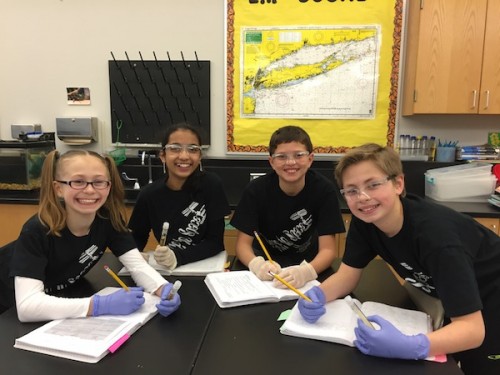
The East Lyme Middle School student flight team preparing for their trials of the Staphylococcus epidermidis biofilm on a rat artery catheter experiment.
Proposal Summary:
The purpose of this experiment is to see if a biofilm will form differently on a rat artery catheter in microgravity from the bacteria Staphylococcus epidermidis, which is naturally occurring in the human body. If the biofilm forms thinner in space than on Earth, this will provide added information to NASA for astronaut health and information for scientists and doctors to hopefully improve catheters and reduce infection on earth. We already know that Staphylococcus epidermidis is a bacterium that is already in the human body for all people. When someone has a catheter in their body, a Staphylococcus epidermidis biofilm can form on it causing this skin infection. The skin disease is an acne-like rash that is red and inflamed. If a person has surgery, he or she is more likely to get a biofilm on their catheter. This happens because Staphylococcus epidermidis likes to stick to any type of plastic. After it sticks it can create a biofilm that clogs the catheter or the implant. This leads to failure and infection (Cuong and Otto 1). We would like our experiment to be running for 2 days on the space station in order for the bacteria to multiply sufficiently. We chose this experiment because many people have died from having this condition known as a Staph infection. This experiment can help because if an astronaut gets sick on the ISS and needs a catheter inserted, we will know better the risks that are involved with this procedure.
HONORABLE MENTION FINALISTS:
Rust Growth on Steel and Iron
Grade 5, East Lyme Middle School, East Lyme School District
Co-Principal Investigators: Julia Locklear, Ava Pitruzzello, Katrina Shevchenko, Kaylyn Wojcik
Teacher Facilitator: Carla Woitovich
Proposal Summary:
For our experiment the question we will address is will rust form on steel and iron
in space? Our hypothesis is that the rust will grow slower and less on both the steel and iron
metals. We think that in microgravity the chemical process of rusting will be affected. We think
the presence of microgravity could slow down the process. We only used four materials: steel,
iron, baking soda, and water. We are going to perform the experiment by exposing 4.5 ml of
water to the two metals. We will do this because when certain types of metals are exposed to
water and oxygen over a long period of time, it forms rust. On the fifth week, we will mix half a
teaspoon of baking soda with the water and stop the rusting process. The baking soda will do this
because it creates a chemical reaction with the water that interrupts the rust’s growth. This is
important because an organization called Mars 1 Foundation is trying to start a civilization on
Mars. If rust forms on the buildings we will need to know how to stop the rusting process. We
are using steel and iron because they are some of the most common building materials and are
known to rust on earth. Iron and steel can be used to make building structures and tools. We will
observe the results by measuring the mass of the metals before and after they are exposed to the
water and with visual observations.
Hydra Physical Changes and New Functions in Microgravity
Grade 6, East Lyme Middle School, East Lyme School District
Co-Principal Investigators: Oliva Goldreich, Julia Smith
Collaborators: Lucas Lewis, Katie Mullins, Kate Pierce
Teacher Facilitator: Linda Nastri
Proposal Summary:
Our group is studying the hydra, which is a Genus creature. It is a microscopic
organism that lives in freshwater. It can have 7-25 tentacles and its mouth on one side of its
slender tube like body, (1\2 – 1\4 in.) and a sticky part on the other side that attaches to
where it is staying, which is called the foot. This is just an experiment to see what might
happen when the hydra is sent into space to try and live. But because of its regenerative
ability, it might be able to live in the microgravity. We also want to put its prey in with it to
see if it might last longer with food. The Hydra prefers to eat Water Fleas, Daphnia, and
almost anything smaller than itself. In this experiment though, we are using water fleas.
We want to know if Hydra can catch its prey in microgravity. So maybe the way it lives in
freshwater might affect its body when it is put in the 10% Neutral Buffer and the 10%
Formalin Fixative. Maybe it will change to adapt in microgravity (Because of its
regeneration) so microgravity might neutralize the effect of when it is stinging its prey with
its nematocysts. This is just an experiment for science, so who knows what will happen!
5. Hillsborough County, Florida
Jump to Hillsborough County’s Community Profile
SELECTED FOR FLIGHT:
Germination of Quinoa in Space
Grade 5, Mabry Elementary School, Hillsborough County School District
Co-Principal Investigators: Jessie Babb, Serena Bassart, Mya Metheny, Julianna Tran
Teacher Facilitator: Jessica Strauss
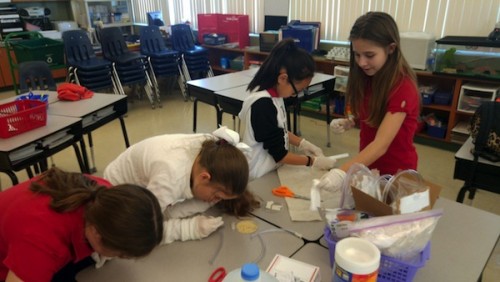
The girls are investigating the amount of quinoa seeds, water, and preservative they would like to use by running trial experiments.
Proposal Summary:
Our group proposes to investigate how microgravity affects the germination of quinoa seeds. We are planning to count the seeds germinating on Earth compared to the seeds that germinate in microgravity with the same investigation. First we will set up the test tube with one clamp separating the murshinge (gel to hold seeds) and the seeds. We would tell the astronauts on board to unclip the clamp and then shake the tube gently (shake from side to side) until the seeds are stuck within the gel. We will count the number of seeds and how they formed in both microgravity and Earth.
HONORABLE MENTION FINALISTS:
Chromatography in Space
Grade 5, Hunter’s Green Elementary School, Hillsborough County School District
Principal Investigator: Caden Long
Co-Investigators: Ethan Stinnett, Shane Win
Teacher Facilitator: Cheryl Pahl
Proposal Summary:
We are doing paper chromatography. We are doing this because we want to see if water can
move ink in space and if microgravity affects how the chemicals in the ink separate on the paper.
The purpose is to see if microgravity affects how ink and chemicals separate in space.
Rust, or Not?
Grade 5, Hunter’s Green Elementary School, Hillsborough County School District
Principal Investigator: Bilal Abouzied
Co-Investigators: Sami Al-Jamal, Chance Young
Teacher Facilitator: Cheryl Pahl
Proposal Summary:
We are doing an experiment on if metal can rust in space. We are putting iron filings on one side
of the tube and tap water on the other side of the tube. Then we will put a clamp in the middle
and then take the clamp and shake the tube for five seconds. Then observe if the iron filings
rusted. We are doing this experiment because if some water gets on the metal spaceship our
experiment will tell if the metal spaceship will rust or not.
6. Boise, Idaho
Jump to Boise’s Community Profile
SELECTED FOR FLIGHT:
Living Water Filters: Triops in Microgravity
Grade 5, North Star Charter School, North Star Charter School District
Co-Principal Investigators: Alexandra Garvin, Bailey Corrigan, Bostyn Corrigan, Raigan Teeter
Co-Investigators: Madeline Clark, Azzio Simontacchi
Teacher Facilitator: Patrice Rex
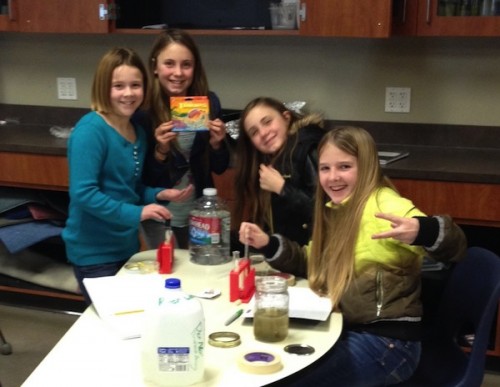
North Star Charter School students Allie Garvin, Bailey and Bostyn Corrigan, and Raigan Teeter optimizing their Triops experiment.
Proposal Summary:
Scientists have wanted to send people to other planets for a long time. We’ll need pipes and plumbing, but what will clean the waste-water produced by people living in space? Triops could possibly be used in microgravity because they eat organisms like bacteria, algae, mosquito
larvae and water fleas that can make the water unsafe for drinking. Triops are small crustaceans that have been on Earth since prehistoric times. They are filter feeders that can remove harmful organisms from water sources. Our experiment will test if test if triops can filter bacteria out of pond water in microgravity as well as they do on Earth. After the experiment is returned to us, we will work the Boise Waste Water Treatment facility to analyze the water to see which kinds of bacteria remain in the water, using a Heterotrophic Plate Count method. We will also measure the mass of the triops that were hatched in microgravity and compare it to the mass of the triops that were hatched on Earth. Water is essential to life; it must be clean for drinking. If it is not clean, it can do harm to the person or animal consuming the water. If triops could function properly in space, astronauts could release triops into the water source to clean it.
HONORABLE MENTION FINALISTS:
Improving Fertility of Mars Soil by Using Anabaena PCC 7120 in Microgravity
Grades 6-7, North Star Charter School, North Start Charter School District
Co-Principal Investigators: Jeremiah Anderson, Ayden Hettinger, Parker Wallace, Ella Wise
Co-Investigators: Madeline Clark, Azzio Simontacchi, Julian Soto
Advisor: Dr. Lynn Rothschild
Teacher Facilitator: Jill Hettinger
Proposal Summary:
Mars, will there ever be life there? Cyanobacteria is a natural choice as a resource for
improving soil for other plants to grow because of its ability to take nitrogen out of the
atmosphere and convert it into ammonia and nitrate in the soil. In addition, cyanobacteria are
better solar collectors than plants, they are edible and provide most vitamins and minerals needed
to sustain a healthy diet, they improve the oxygen levels in the atmosphere, and they can be used
to produce fuel making them a great resource of space travel (Stone, 2015). Most cyanobacteria
use photosynthesis to produce sugars that they require to grow, however, some cyanobacteria are
able to use a secondary pathway to access sugars from their environment when it is dark. Do to
the limitations of the FME mini-lab we will be using Anabaena sp. strain PCC 7120 which is
able to grow in the dark using fructose from its environment (Stebegg, Wurzinger, Mikulic, &
Schmetterer, 2012). Additionally, Anabaena sp. strain PCC 7120 has been successfully grown on
Mars soil simulant within a 1G environment (Verseux, de Vera,Lehto, & Rothschild, 2015).
Wamelick et. al. (2014) identified the need for research into how gravity influences the growth
of organisms in Mars soil. The reason for our experiment is to discover how well Anabaena PCC
7120 is able to grow on and to cause nitrification of Mars soil in microgravity. We will be using
a Type 3 FME mini-lab to implement this experiment.
Epigentetic Changes in Caenorhabditis Elegans as a Result of Microgravity
Grades 7 and 11, North Star Charter School, North Start Charter School District
Co-Principal Investigators: Kaden Baxter, Connor Betz, Gabe Evans, Josie Lipps, Darin Neuberger
Co-Investigators: Roxy Boucher, Julia Galenko, Cassidy Puatu, Kylie Smith, Jessica Stelzner
Advisor: Jon Pierce-Shimomura
Teacher Facilitator: Jill Hettinger
Proposal Summary:
Caenorhabditis elegans (C. elegans) are a small roundworm about 1mm long. They have
been used in multiple experiments that have been conducted on the ISS, including a SSEP
experiment during mission 3 that was interested in seeing if C. elegans would survive the
microgravity environment (SSEP, 2012). It is now well understood that C. elegans will survive
in microgravity (Higashitani, 2015). Our experiment seeks to discover if the environmental stress
of microgravity will cause changes in the epigenetics of C. elegans. Specifically, we will
compare the epigentic effect of microgravity on muscular dystrophy worms that already express
atrophy in their muscles and healthy wild-type N2 worms. We chose to work with C. elegans
because they have been used successfully in microgravity. We will be using a Type 2 FME minilab
that will contain a two small population of C. elegans N2 wild-time and C. elegans dys-1
mutant worms in E.coli enriched agar. The dys-1 mutant worms have been genetically
manipulated to be green in color, and the two worm types will not cross-breed. We expect our C.
elegans samples to go through a minimum of three generations while on the International Space
Station.
7. Potomac, Maryland
Jump to Potomac’s Community Profile
SELECTED FOR FLIGHT:
Shewanella oneidensis and Iron Ions in Microgravity
Grade 10, Bullis School
Co-Principal Investigators: Skylar Jordan, Amanda Kay
Advisor: Dr. John Ondov
Teacher Facilitator: Daniel TerBush
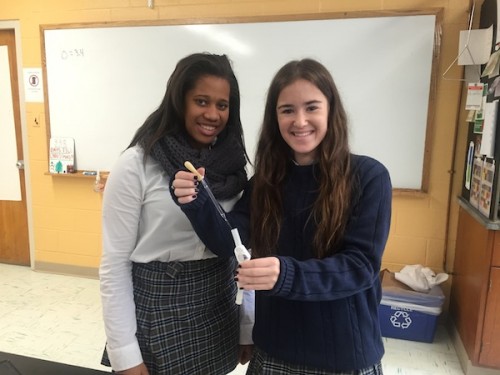
Bullis School students Skylar Jordan and Amanda Kay prepare their FME mini-lab for flight to the ISS.
Proposal Summary:
We expect that the process by which Shewanella oneidensis removes metal ions from water will not differ in microgravity compared to normal gravity. Water is a necessity for human life and everyday, many metals are found in important water sources. Many people do not realize how the water they are consuming are contaminated with heavy metals. Excess amounts of heavy metals can destroy vital human organs such as the brain and liver. This experiment tests how Shewanella oneidensis can remove heavy metals from contaminated water which will help future water contamination issues if the results come back as expected. First, data will be collected based on the amount of iron ions present in the water before coming in contact with Shewanella oneidensis. This will be collected before sent to the International Space Station (ISS). Data will also be gathered for the amount of iron ions in the water after coming in contact with the bacteria. This data will be collected after the experiment comes back from the ISS. Since the hypothesis states that gravity will not effect the removal process, the amount of iron ions present in the microgravity experiment are expected to be the same as the amount present in the ground experiment. When both experiments are back in the lab, we will compare the amount of iron ions in the solutions to tell if Shewanella oneidensis removed iron ions differently in the two different environments and whether or not gravity affects the removal process of iron ions.
HONORABLE MENTION FINALISTS:
Growth of Aloe Vera in Space
Grade 8, Bullis School
Co-Principal Investigators: Marianna Anagnostou, Joey Chmara, Danielle Dyer, Olivia Kazanjian
Teacher Facilitator: Chelsea Henry
Proposal Summary:
The proposed question is, what is the effect of microgravity on the germination of an Aloe Vera
seed? Aloe Vera has a variety of uses in the medical and cosmetic fields that make it a very
important contribution to these industries. Additionally, Aloe Vera is used to aid in treating a
variety of sicknesses and diseases such as constipation, hemorrhoids, asthma, colds, bleeding,
colitis, depression, diabetes, multiple sclerosis, and epilepsy. We will prepare an FME containing
two Aloe Vera seeds, cactus soil, and water. One to be conducted on earth, and one to be
conducted in space. If we determine that Aloe Vera seeds germinate better in space, then this
could mean that more Aloe Vera can be grown at the ISS and will make for more derivatives
from the plant to be used for medical and cosmetic purposes. This experiment will help us
answer the proposed question of regarding the germination of Aloe Vera seeds in space.
The Effect of Microgravity on the Birth Rates and Early Development of
Nothobranchius Rachovii
Grade 10, Bullis School
Co-Principal Investigators: William Evans, Liam Vinal
Teacher Facilitator: Daniel TerBush
Proposal Summary:
The hypothesis of the experiment is that less fish will be born in the microgravity environment
because their bones and muscles will not be able to develop as quickly and the unnatural
microgravity environment will cause less fish to hatch. The experiment will test birth rates to see
how complex organisms develop in space from an early age. The hypothesis will be tested to see
if organisms will be able to develop in space. Fish eggs will be sent into space in the tube, and
the same amount of fish eggs in the same tube will be kept at home. We will hatch the eggs in
space, as well as back on earth, and after two days euthanize and preserve them. The birth rates
will tell us how microgravity affects their development. The expected results are that fewer eggs
will hatch in space than back home. The birth rates will tell us if complex organisms, such as
humans, would be able to develop from an egg state in space.
8. Fitchburg, Massachusetts
Jump to Fitchburg’s Community Profile
SELECTED FOR FLIGHT:
Streptococcus mutans Production of Lactic Acid in Microgravity
Grades 10-11, Montachusett Regional Vocational Technical High School, Montachusett Regional Vocational Technical School District
Co-Principal Investigators: Olivia Houle, Shelby Landress
Collaborators: Madison Clark, Zachary Houle
Teacher Facilitator: Paula deDiego
Proposal Summary:
This experiment has the potential to be successful in finding a more efficient dental care regimen for astronauts. The factor to be observed in the experiment is whether or not Streptococcus mutans produce more lactic acid in microgravity and if the reproduction rate of the previously stated bacteria is affected in space. Improper oral hygiene is a factor that contributes to poor health in the rest of the body. If the Streptococcus mutans prove to be a greater force in space than they do on Earth, then the aseptic habits of astronauts may need to be modified. Previous studies referenced in this proposal reinforce the hypothesis that dental caries are more likely to occur in space because of how microgravity influences S. mutans.
HONORABLE MENTION FINALISTS:
The Resistance of Fluconazole on Candida dubliniensis in Microgravity
Grade 10, Montachusett Regional Vocational Technical High School, Montachusett Regional Vocational Technical School District
Co-Principal Investigators: Abbigayle McIntosh, Abigail Clark
Teacher Facilitator: Paula deDiego
Proposal Summary:
Our whole project revolves around if Candida dubliniensis is more resistant or less
resistant to the anti-fungal drug Fluconazole in microgravity. Candida dubliniensis is a fungus
that is commonly found in HIV patients, or someone who is immunocompromised, but in rare
cases can be found in healthy patients. Candida dubliniensis causes yeast infections, in HIV
patients the fungus usually presents itself in the oral cavities, but also can be found in fecal
matter, urine, can cause oropharyngeal, and vaginal and bloodstream infections. Researchers had
figured out that the fungus’ ATP keeps the CDR 1 and CDR 2 activated, thereby leads to the
fungus’ resistance to the anti-fungal drug fluconazole. We would like to find out is if the
production of ATP slows down, would the CDR 1 and CDR 2 in the cells genes become
inactivated and make Candida dubliniensis susceptible to the drug fluconazole.
Bifidobacterium longum in microgravity
Grades 10-11, Montachusett Regional Vocational Technical High School, Montachusett Regional Vocational Technical School District
Co-Principal Investigators: Alexis Arsenault, Jessie Cote, Kristyn Gordon, Grace Kirrane
Teacher Facilitator: Paula deDiego
Proposal Summary:
Our experiment consists of testing the growth of Bifidobacterium longum in
microgravity. Through this experiment we will discover whether or not the product of the
bacteria is greater or has decreased when in microgravity. In space, astronauts immune systems
tend to weaken due to less cell activity. As cell activity decreases, the body’s immunity weakens.
Their risk of illness and infections is higher. Here on earth Bifidobacterium longum helps
citizens to maintain good digestion, boost the immune system, and produce lactic and acetic acid
that control intestinal pH.
9. Traverse City, Michigan
Jump to Traverse City’s Community Profile
SELECTED FOR FLIGHT:
Growth of Blue-Green Algae in Space
Grade 10, Traverse City West Senior High School, Traverse City West High School
Co-Principal Investigators: Sam Church, Ryan Hayes, Hayden Holmes, Robert Lohr
Teacher Facilitator: Patrick Gillespie
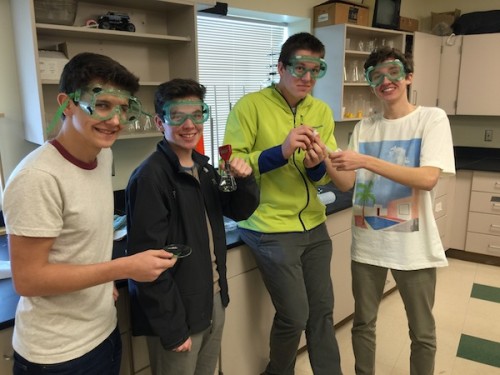
Sophomores Hayden Holmes, Sam Church, Ryan Hayes, and Robert Lohr, planning how to measure results in the “Algae Growth in Space” experiment.
Proposal Summary:
We are testing the growth of Blue-Green algae to see if the growth changes when it is put in space, We want test this because the blue-green algae produces hydrogen and oxygen, so that later in the future when we’re in space we can use the oxygen to breathe and the hydrogen as fuel. We will be putting the algae in the capsule with water, a rock, and plant fertilizer for nutrients. We will have the same rocks, amount of water, and amount of algae here on earth.
HONORABLE MENTION FINALISTS:
Difference in Oil Absorbency Between Gravity and Microgravity
Grade 10, Traverse City West Senior High School, Traverse City Area Public Schools
Co-Principal Investigators: Lauren Camp, Joel Cerny, River Leachman, Alexis Zoutendam
Teacher Facilitator: Patrick Gillespie
Proposal Summary:
We propose to combine 3 ingredients, (3.5 ml of water, 3.5 ml of oil, and a feather) to see
if gravity on earth compared to no gravity in space will effect how much oil gets absorbed in the
feather. This idea was inspired to us by thinking that oil and water can mix in space rather than
on earth. They won’t mix because of gravity, it’s just layers with oil being the top layer and water
the bottom layer. As a group we believe that in space the feather will absorb more oil because
it’s mixed into the water better. We tested on earth the oil absorption of a feather to be able to
compare to the feather going to space. The feather gained 0.0835g of oil. We will use this data to
see whether absorption in space is greater. On earth with the gravitational force oil layers on top
of water so it would absorb less water having only the oil on top to absorb into the top of the
feather. This experiment would benefit resource transportation in space because we would know
the extent of how oil and water mixes in space when transporting oil and water in an oxygenated
environment. Resource distribution could troubleshoot oil and water spills in space better with an
understanding of how oil and water mix in space. When transporting resources to inhabit planets
such as Mars, we will need to know how oil and water mix in zero-gravity.
Cell Growth in Microgravity
Grade 10, Traverse City West Senior High School, Traverse City Area Public Schools
Co-Principal Investigators: Ashley, Caughell, Anna Jarvis, Ana Walters
Teacher Facilitator: Patrick Gillespie
Proposal Summary:
Our proposal is cell growth in microgravity, specifically the ‘immortal’ cell line of
Henrietta Lacks’s cervical cancer. We will be using a Type 2 FME tube for our experiment.
Volume one will contain the HeLa cells and volume 2 will contain the growth medium RPMI
1640. The idea and hope is that the cells with the growth medium will have significantly
different growth results than same experiment on earth. By running this experiment we can see
the effects of microgravity on the growth and reproduction of human cells. We plan to have the
astronauts unclamp the tube on day 1 and vigorously shake for 30 seconds in order to expose the
cells to the medium as soon as possible . After that, we plan for there to be no interactions until
day 4, which will consist of 10 seconds of gentle shaking. When our experiment returns, we will
document the appearance, mass, and any change in the shapes of the cells after growing in
microgravity.
10. Jersey City, New Jersey
Jump to Jersey City’s Community Profile
SELECTED FOR FLIGHT:
The Effects of Microgravity on Muscle Tissue Regeneration
Grade 12, McNair Academic High School, Jersey City Public Schools
Co-Principal Investigators: Joshua Monserate, Jay Pandya, Nirav Patel, Sardar Hamza Zakria
Teacher Facilitator: Maria Emma Osoria
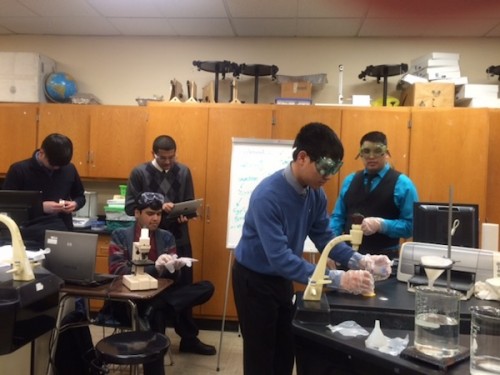
Jersey City Student researchers are working on tissue dissections and testing for the solubility of the selected medication for their experiment.
Proposal Summary:
The aim of the experiment is to analyze the potential of the drug, Tissue Regeneration Factor at 150 mg (TRF-150) to regenerate shoulder muscle tissue of an adolescent pig faster when exposed to a microgravity environment. Therefore, the analysis aforementioned will determine the amount of tissue regenerated under controlled scenarios of induced harm. Both qualitative and quantitative methods of measurement will be used to determine this experiment’s success. Quantitative measurements include density of the remaining tissue and amount of oxygen and glucose consumed. Qualitative analysis will include placing the tissue under a scanning electron microscope to visually determine how much of the tissue has regenerated and the pattern of the issue regenerated. This experiment will be conducted in a Fluids Mixing Enclosure (FME) Mini-lab type 3 with a solution of formaldehyde and TRF-150 at the edges of the tube, in the middle of the tube will be the tissue in question with a controlled incision made on it and a solution of glucose, proteins, oxygen and testosterone. This experiment will help determine if a microgravity environment aids in the regeneration of organic tissue. If the experiment implies the increase of the regenerative properties of TRF-150 then simulated microgravity environment can be implemented to help patients enduring a muscle injury.
HONORABLE MENTION FINALISTS:
Does Microgravity Affect the Sex Ratio of Fruit Flies (Drosophila melanogaster) in
a Microgravity Environment?
Grade 5, Public School 27, Jersey City Public Schools
Co-Principal Investigators: Arhaan Misra, Kevon Owusu, Joshua Torres, Johann Varghese
Teacher Facilitator: R. Ernesto Burgos
Proposal Summary:
Our experiment is to explore if microgravity affects the sex ratio of fruit flies wild
Drosophila melanogaster during development in microgravity compared to their development on
Earth. The fruit fly’s sex is determined during the pupae stage of its life cycle. Both fruit flies and humans have X and Y chromosomes but fruit flies only have 8 chromosomes compared to the 46
that humans have. Unlike humans, the Y chromosome doesn’t determine the fruit fly’s sex but
instead helps make genes for a male fruit fly to reproduce. The fruit fly’s sex is determined by the
ratio of its X chromosomes to its autosomes. Each cell decides whether the fruit fly should be a
male or female that sometimes produces gynandromorphs (having both male and female body
parts). Scientists can further test to see how these potential changes will affect the ecosystems in
the biospheric environment on the moon or Mars, where there is much less gravity than on Earth.
Microscopes will be used to determine the sex ratio of males to females produced in microgravity.
We hypothesize that the sex ratio will be favorable to females. Thus more female fruit flies will
survive in microgravity, because previous experiments show that exposed fruit flies to sudden
changes in temperature using an incubator has shown that female fruit flies can withstand harsh
changes in their environment better than males. Since female fruit flies carry hundreds of eggs
after mating, their bodies can withstand harsher changes to their environment.
Effects of Microgravity on Neuronal Morphology
Grade 12, McNair Academic High School, Jersey City Public Schools
Co-Principal Investigators: Serena Tang, Raefah Wahid
Co-Investigators: Kush Baldha, Nikunj Jhaveri, Miraj Patel
Teacher Facilitator: Maria Emma Osoria
Proposal Summary:
In this experiment, analyses about the morphological changes that are experienced in
neuronal cells’ synapses in microgravity will be conducted. Data about neurons from a
microgravity environment will be compared with those in Earth’s gravitational environment in
order to qualitatively and quantitatively form conjectures about the changes in the mental
abilities of astronauts (such as memory performance, information recollection, etc.).
The experiment will be conducted using hippocampal neurons from a rat’s brain, a
Neurobasal medium, and a culture kit from BrainBits. The neurons will be transfected with the
hChR2 gene, which will allow the cells to express a light sensitive protein called
channelrhodopsin-2. These proteins will allow the neurons to fire only in the presence of blue
light (~470 nm). The tube will be covered on the inside by a phosphorescent blue film, which
will allow blue light to enter the tube in the dark after being charged by ambient light. The
neurons will be kept in a dark environment and surrounded by cold packs until the tube reaches
the International Space Station (ISS). After approximately three days on the ISS, a fixative of
6.5% paraformaldehyde in phosphate-buffered saline (PBS) will be released to preserve the
culture until it is brought back to Earth for analysis. When the culture reaches Earth, a
Transmission Electron Microscope (TEM) will be used to conduct synaptic analyses and form
conjectures.
11. Springfield, New Jersey
Jump to Springfield’s Community Profile
SELECTED FOR FLIGHT:
The Effects of Microgravity On Grass Seeds’ Growth
Grade 7, Florence M. Gaudineer Middle School, Springfield Public Schools
Co-Principal Investigators: David Ares III, Jeremy Dash, Daniel Munoz
Co-Investigators: Timothy Burns, Antonio Nacci
Teacher Facilitator: Alison Gillen
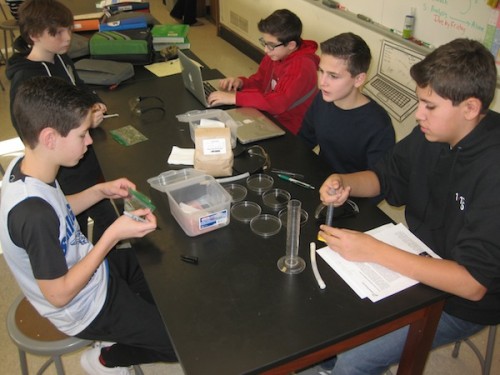
Grade 7 student researchers experimenting with optimal germination conditions for studying the effects of microgravity on the growth of grass seeds.
Proposal Summary:
We are interested in seeing if microgravity affects the growth rate of plant seeds. In our experiment we want to test the effects of microgravity on the growth of Rye grass seeds. Our group is also testing to see if Rye grass seeds are able to grow without gravity and light. We have found conflicting information during our research. We have been taught in school, through books that gravity affects the way seeds are grown. The roots grow in the direction of gravity. However, in the articles we read online, it was written that gravity had little affect on the way seeds were grown. We think the benefit of trying to grow seeds in microgravity is: if people needed to stay in space for long periods of time, they need to know the total effects of microgravity on plant growth. We think that the seeds will grow in microgravity and their growth will increase more than on Earth. For our experiment to start the seeds’ growth, we will only give our seeds water. In our three-chambered tube we will put water in volume 1, Rye grass seeds in cotton to keep them in place in volume 2, and in volume 3, we will have salt for our fixative. Because of the tests we have done we know that on average a Rye grass seed take 5-12 days to grow. And we have been able to stop the growth using a salt solution.
HONORABLE MENTION FINALISTS:
Brine Shrimp Growth Rates in Microgravity
Grade 7, Florence M. Gaudineer Middle School, Springfield Public Schools
Co-Principal Investigators: Jordan Berkowitz, Ryan Disko, Dexter Kennedy, Ryan Sickinger
Teacher Facilitator: Alison Gillen
Proposal Summary:
We are interested in the rates of growth of brine shrimp, if they grow faster or slower in
microgravity. Brine shrimp are small organisms that take around 8 days to become an adult.
Microgravity is a fantastic environment to explore the potential of brine shrimps growth rate
changes! This information could help future exploration by showing if it is safe to grow
organisms in space. This research could help to find out information for the unknown affects of
microgravity. We anticipate that the results of the growth rate of brine shrimp will increase, since microgravity contains near weightlessness conditions. For our experiment, the brine shrimp will be given salt water to start their development. After nine days, the chamber will be flooded with a growth inhibitor. This will allow us to stop their growth. Once the brine shrimp have returned to Earth, we can compare abnormal growth, accelerated growth, or any other differences.
The Breakdown of Penicillin with Beta Lactamase in Microgravity
Grades 10-11, Jonathan Dayton High School, Springfield Public Schools
Co-Principal Investigators: Carly Gartenberg, Alexandria Giordano, Ashley Korieocha, Jessica Lagemann
Teacher Facilitator: Jennifer Greenspan
Proposal Summary:
Penicillin, which is often described as a “miracle drug”, is a vital antibiotic that fights infections
that interfere with the cell wall of bacteria. One problem that scientists and doctors face with this
drug is that bacteria are forever changing to develop immunity to penicillin. If given the
opportunity to send an experiment into space with the Student Spaceflight Experiments Program,
our group would like to investigate the effect of microgravity on the breakdown of penicillin by
beta lactamase, an enzyme that breaks down penicillin. To complete this experiment, we will use
liquid forms of penicillin and beta lactamase and ask astronauts to mix the two by shaking them
gently. This will allow the two liquids to interact, ultimately causing the breakdown of the
penicillin. Then, we will preserve the structure of the broken down penicillin with Formalin FBF
and observe it on Earth using mass spectrometry. Our experiment might prompt future scientists
to investigate infections that can be found in space and their resistance to penicillin. This could
help any future space travellers and the future generations that could eventually live in space.
12. Buffalo-Niagara, New York
Jump to Buffalo-Niagara’s Community Profile
SELECTED FOR FLIGHT:
Tuber Transport and Subsequent Terrestrial Growth
Grades 7-8, Hamlin Park Claude and Ouida Clapp School #74, Buffalo Public Schools
Principal Investigator: Gabriella Melendez
Co-Investigators: Toriana Cornwell, Shaniylah Welch
Advisors: Dr. James Berry, Dr. Mary Bisson, Cornell Agricultural and Life Sciences Department
Teacher Facilitator: Andrew Franz
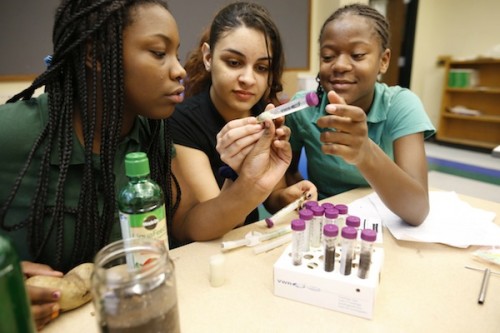
From left: Shaniylah Welch (Co-investigator), Gabriella Melendez (Principal Investigator) and Toriana Cornwell (Co-investigator) examine one of the experiment samples.
Proposal Summary:
This project is about the germination of Yukon gold potatoes because of the distinct lack of grocery stores in outer space. Plants on earth develop under the influence of gravity. Plants must support themselves against the force due to gravity. On the International Space Station, a vehicle that is in constant free fall, gravity does not hold the same effect (microgravity). We believe that germination in small containers is necessary to eventual planetary terraforming (you can start the growth process before landing on another planet). We wish to try to grow potatoes on the International Space Station so we can see if the plants will be able to grow on other planets, or travel there.
HONORABLE MENTION FINALISTS:
The Effect of a Microgravity Environment on the Rate of Breast Cancer Cell Growth
Grades 10-11, Global Concepts Charter High School, Global Concepts Charter High School
Co-Principal Investigators: Zaina Alsadam, Kendall Cerrone
Advisor: Dr. Adam Kisailus
Teacher Facilitator: Rebecca Poremba
Proposal Summary:
About 1 in 8 U.S. women will develop invasive breast cancer over the course of her lifetime.
Breast cancer cells migrate in an unregulated fashion called metastasis. Here on Earth, metastasis
is controlled by gravity. Our experiment involves sending live breast cancer cells to the
International Space Station to see the rate at which breast cancer cells grow in a microgravity
situation. The results of this experiment will determine the effect of gravity conditions on breast
cancer tumorigenecity. Measuring the rate of metastasis in a controlled microgravity
environment on this small scale could also allow scientists the ability to see what would occur if
they changed the dynamics of the environment in which the cancer cells are growing, gaining
insight into experimental microgravity therapies for cancer.
The Battle of Antibiotics vs. Bacteria in Microgravity
Grade 5, Harry F. Abate Elementary School, Niagara Falls City School District
Co-Principal Investigators: Louis Lodovico, Michelina Renda, Genesis Sanders, Parker Urban
Advisor: Dr. Mark Gallo
Teacher Facilitator: Ronni McGrath
Proposal Summary:
For our microgravity experiment, we will investigate if antibiotics still work to kill
bacterium in microgravity. Our purpose is to give aid to the astronauts if they are ill. In our
research, we are using E.coli, but in microgravity experiment and our ground truth experiment
we will use bacterium grown by yogurt because it is a lot safer. We don’t want to make the
astronauts sick. We will send liquid antibiotics and dormant bacterium in the FME. The bacterium is
affected when it is exposed to the liquid antibiotics. We have learned that astronauts have
lowered immune functions while in microgravity so this research is important. Our hypothesis is
that if we put antibiotics in a test tube with the bacterium, it will still kill the bacterium because
the chemicals in the antibiotics will reach the bacterium no matter what.
13. Eugene, Oregon
Jump to Eugene’s Community Profile
SELECTED FOR FLIGHT:
SLIPS in Microgravity
Grade 8, Arts and Technology Academy, Eugene School District 4J
Co-Principal Investigators: Ray Newell, Garrett Price, Kobe Skidmore
Teacher Facilitator: Kathleen Taylor
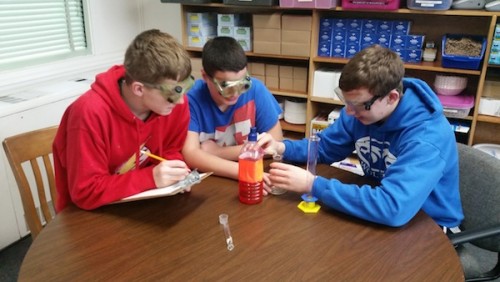
Garrett Price, Kobe Skidmore and Ray Newell of Arts and Technology Academy in Eugene examine properties of a solution.
Proposal Summary:
Does Slippery Liquid-Infused Porous Surfaces (SLIPS) decrease the scale of an omniphobic surface in microgravity? An Omniphobic Surface scale is a measurement of how slippery something is. SLIPS is the world’s slipperiest substance, it has been out for half a year, and is based off the functionality of the pitcher plant. After it rains pitcher plants keep raindrops as a film on the edge of their mouth so that when ants walk on the rim, they slip into their stomach. SLIPS only does one thing, it makes a surface of a solid slippery so that no liquid can touch the face of the solid that’s coated. We are testing SLIPS in a microgravity environment to find out if it has the same properties as it does on Earth. If it does it could possibly solve frostover for rockets at launch and in microgravity. We will be using a type 3 FME. Inside volume 1 we will have a cotton ball. Inside Volume 2, there is an aluminum strip 12.5mm x 35mm coated with SLIPS on one side. In volume 3 there will be 1.5ml of corn syrup. The tube will be coated on the inside with SLIPS in both volume 2 and 3. In this experiment we are hoping to solve frostover on the ISS with SLIPS by finding if SLIPS can not only stay on the face of a solid but still make liquids slip off of the solid.
HONORABLE MENTION FINALISTS:
Salvica Hispanica in Microgravity
Grades 7 and 12, Arts & Technology Academy and Churchill High School, Eugene School District 4J
Co-Principal Investigators: Daniel Campos, Alex Kanning, Kylie Miles, Miranda Thiesmeyer, Jacob Roach, Sophie Van Sell
Teacher Facilitators: Daniel Morphis and Evan Munger
Proposal Summary:
For our experiment we are proposing that we send Salvica Hispanica seeds into space to see if
they can grow. If they work then that will mean that we can send the seeds into space so that
astronauts can have a large source full of protein, fiber, calcium, and other vitamins and nutrients
all in one plant. Salvica Hispanica is a great and healthy food that can be put into many different
meals and can be prepared many different ways.
Sea Monkey Astronauts-The Life Cycle of Artemia nyos in Microgravity
Grades 11-12, Churchill High School, Eugene School District 4J
Co-Principal Investigators: Alexander Cordova, Aileen Hernandez, Gabe Peterson-DeGroff, Beau Scott, Brycen Spencer, Sierra Squires
Teacher Facilitator: Evan Munger
Proposal Summary:
Our group decided to focus our experiment around the topic of marine life in space. Brine
Shrimp, which are a very sturdy animal that does not need any special accommodations, will be
the subject of our experiment. On Earth everything is effected by gravity one way or another.
Organisms have muscles in their body to lift and push themselves away from Earth’s
gravitational pull. Aquatic life is no different. Organisms have muscles to push on the water
around them in order to not sink from gravity trying to pull it down. Our experiment is intended
to take that variable, gravity, and decrease its strength and record the effects. Since we are not
able to send a camera, or other electronics, up to the ISS to watch every move, we plan on
recording the data in a few other ways. One of which will be food consumption. We can hold a
control down on Earth and track the difference in the amount of food that is consumed. By that
we can make assumption as to which group of shrimp are burning more energy.
14. Columbia, South Carolina
Jump to Columbia’s Community Profile
SELECTED FOR FLIGHT:
The Effects of Microgravity on the Turbidity of a Non-Newtonian Fluid Mixture
of Cornstarch and Water
Grade 9, W.J Keenan High School, Richland School District One
Co-Principal Investigators: Cedric McQueen, Ryan Mathews, Tevin Glover
Teacher Facilitator: Kirstin Bullington
Proposal Summary:
My group’s research question is, “How does microgravity effect the turbidity of a Non-Newtonian mixture, cornstarch and water?” Turbidity is the measure is the measure of light that can pass through a water sample. When the turbidity of a mixture is higher, the temperature is higher due to absorbed heat. Cornstarch is obtained from the endosperm of the corn kennel. In regular gravity, this non-Newtonian fluid is hard when you hit it hard or fast, but when you operate in a slow motion it acts like a liquid. When left to settle, the mixture separates somewhat due to gravity, so we were curious if microgravity would affect the initial mixing and then its settling. We plan to use a Type II FME, in which cornstarch should take up 6.9ml of the tube, and distilled water should take up 2.3ml. The interactions requested are to first unclamp the FME and shake vigorously to create the mixture. Before leaving the ISS, we request that the FME be reclamped in its original place. That way, despite agitation during re-entry and shipment, we can compare the turbidity of the two samples to determine how well the sample mixed and stayed mixed in microgravity. The same setup will be used in regular gravity for comparison to determine what effect, if any, microgravity had on the non-Newtonian fluid mixture. Turbidity will be measured through a myDaQ turbidity sensor and by spectrophotometer.
HONORABLE MENTION FINALISTS:
The Effect of Microgravity Exposure on crystallized Halobacterium sp. NRC-1
Growth
Grade 9, W.J. Keenan High School, Richland School District One
Co-Principal Investigators: Kynda Beckett, DeShawna Black, Victoria Chandler
Teacher Facilitator: Kirstin Bullington
Proposal Summary:
Microgravity is the condition in which people or objects appear to be weightless. The
purpose of our project is to determine the effect of microgravity exposure on crystallized
Halobacterium sp. NRC-1 growth on BSYC agar (when returned). The question to be addressed
is “What is the effect of microgravity exposure on the growth of Halobacterium sp. NRC-1 once
plated and grown on BSYC agar?” Little is known about Halobacterium, but what we do know
is that they are extremophile bacteria that live in water with high salt concentrations (S.
DasSarma, 2014) and are prokaryotic specimens. It makes sense to conduct this experiment due
to halophiles having very little testing in space due to its response to microgravity. This bacteria
requires high levels of NaCl (salt) to grow. NaCl is required because they cluster close together
rather than far apart like other archaea to create sequences of 16srDNA. We hypothesize that the
bacteria (halophiles) growth rates will decrease in microgravity. We already know that there are
different ways to grow Halophiles. Depending on the different solutions used, the bacteria in that
will determine the growth rate and effect. In our projects, the independent variable is
microgravity, the dependent variable is the differences between the ground-truth FME and the
space FME populations of crystallized Halobacterium sp. NRC-1, to be measured by colony
count once plated upon return.
How does microgravity affect the rbcL gene sequence in Rosa radrazz?
Grade 9, W.J. Keenan High School, Richland School District One
Principal Investigator: Nya Davenport
Co-Investigators: Jada Bouknight, Christasia Scott, JaQuaris Tobias
Teacher Facilitator: Kirstin Bullington
Proposal Summary:
This experiment is being done to determine how microgravity affects the DNA of Rosa
radrazz, known as knockout roses. The knowledge that we will get from our experiment will
help us understand plants and the way they work, allowing us to figure out new ways to support
plant life in space, specifically chloroplast DNA. Also, according to an article by Dr. Anireddy Reddy, “Plant Growth in Microgravity”, “The mechanisms involved in gravity signal perception and transduction are intensely investigated in ground-based experiments using a variety of approaches such as clinostats, mutants, and changing the position of plants with respect to gravity.” However, not much is known about the effect of microgravity on various qualities of plant development due to the inability to create microgravity conditions on Earth for a prolonged time.
Our experiment answers the question “Does microgravity exposure affect the sequence of
the rbcL gene in Rosa radrazz when compared to the rbcL sequence from the same plant in
Earth’s gravity?” We will be harvesting a leaf of a Rosa radrazz and preserving in 91% isopropyl
alcohol to prevent its DNA from degrading from decomposition. When the FME comes back we
will extract the leaf DNA, isolate and amplify the rbcL gene through PCR, and compare
sequences, following the DNA barcoding procedures outlined by DNALC. The hypothesis of our
experiment is that if the rbcL gene in Rosa radrazz is exposed to microgravity, then more
changes in the rbcL nucleotide sequence will be detected.
15. North Charleston, South Carolina
Jump to North Charleston’s Community Profile
SELECTED FOR FLIGHT:
How does Spaceflight Affect the Detachment of Zinc Whiskers?
Grade 11, Palmetto Scholars Academy, South Carolina Public Charter School District
Co-Principal Investigators: Kayla Capitan, Gabriel Voigt
Teacher Facilitator: Kellye Voigt
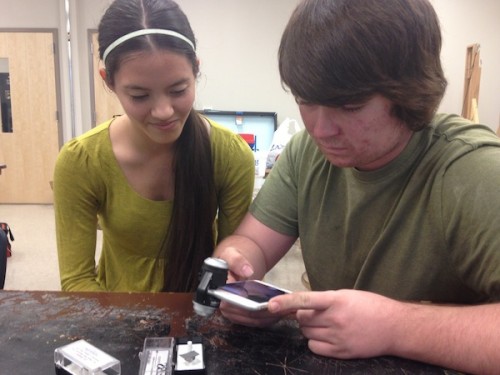
Kayla Capitan and Gabriel Voigt examine a whiskered zinc-plated floor tile with a 30x camera zoom and a iPhone 6 Plus.
Proposal Summary:
How does spaceflight affect the detachment of zinc whiskers? Metal whiskers cause large-scale damage to electronics by interfering circuits and electronic interfaces. These tiny threedimensional crystalline structures cause great damage, although most whisker-induced failures are left unreported due to lack of understanding and proper analysis methods. Although zinc was used to mitigate tin-whisker failure modes, zinc has displayed full capability of disrupting electric circuits and creating undesired connections between these circuits, resulting in shorts. The scientific community has limited knowledge and understanding of the behavior of metal whiskers, especially of detachment and of zinc whiskers, putting this experiment at the culmination of whisker behavior and whisker failure mode comprehension.
HONORABLE MENTION FINALISTS:
How does Microgravity Affect Kevlar Fibers Immersed in an Aqueous Solution?
Grades 10-11, Palmetto Scholars Academy, South Carolina Public Charter School District
Principal Investigator: Kayla Capitan
Investigator: Gabriel Voigt
Collaborator:Mckoy Floyd
Advisor: Lyle Blevins
Teacher Facilitator: Kellye Voigt
Proposal Summary:
How does microgravity affect Kevlar fibers immersed in an aqueous solution? With increased
interest in complex space missions, materials that express high-strength capabilities and high
performance such as DuPont’s Kevlar XP S104 are required to provide protection. Kevlar is a
material more commonly used for the production of protective vests and equipment. This
experiment will immerse Kevlar fibers in an aqueous solution in order to mimic potential humid
environments or condensation. If the DuPont product Kevlar XP S104 fibers proves resilient
enough for spaceflight the use of these fibers should be evaluated to enhance equipment (from
space suits, vehicles, spacecraft, etc.). If Kevlar is applied to 3D printing, it will strengthen and
improve the materials’ abilities. Carbon 3D printers combine the rubber-like qualities of
thermoplastics and the strength and durability of carbon fibers, like Kevlar. Opportunities like
the use of Kevlar can lead to transforming the ISS into a functional additive manufacturing
network that will advance astronauts’ abilities and safety. Since Kevlar fibers are so versatile, its
potential applications are boundless.
The Effect of Microgravity on the Antimicrobial Activity of methicillin against
Staphylococcus epidermidis
Grade 10, Palmetto Scholars Academy, South Carolina Public Charter School District
Co-Principal Investigators: Aiden Durand, Griffin Eslinger
Teacher Facilitator: Niquie Ragland
Proposal Summary:
This experiment will test how microgravity affects the antimicrobial activity of methicillin against the bacteria Staphylococcus epidermidis. During the experiment, methicillin will be introduced to a culture of S. epidermidis in both microgravity and on Earth. A type 3 FME will be used, containing methicillin, agar and water, and S. epidermidis. The bacteria culture will be activated with the agar and water, then methicillin will be introduced to kill a portion of the population. When the FME returns to the team, they will analyze the live/dead ratio of bacterial cells. The analysis will be done by staining a small sample of the bacteria, and counting how many are stained under a microscope and comparing with the number of unstained cells. A flow cytometer may also be used to determine how many cells died. The results of this experiment can be used practically to prescribe antibiotics to astronauts. Methicillin has been used to test the penicillin family of antibiotics, and S. epidermidis is a commonly used bacteria that is easy to grow, and is closely related to some commonly pathogenic bacteria such as Staphylococcus aureus. The team hopes to find a significant difference, which can be used to recommend the appropriate type or amount of antibiotic to keep for astronauts who may become sick on longer missions so that they can perform their jobs.
16. Knox County, Tennessee
Jump to Knox County’s Community Profile
SELECTED FOR FLIGHT:
Testing the Effectiveness of Tobramycin and Dexamethasone Ophthalmic
(Tobradex) on Staphylococcus Aureus Type of Bacterial Conjuntivitis in Microgravity
Grades 7-8, Bearden Middle School, Knox County Schools
Co-Principal Investigators: Moamen Emara, Alex Hoffman, Elise Kersch, Jack Lathrop, James Pierce, Mauricio Sanchez, Riley Speas, Katherine Trent, William Walker
Teacher Facilitators: Kayla Canario, Virginia Brown
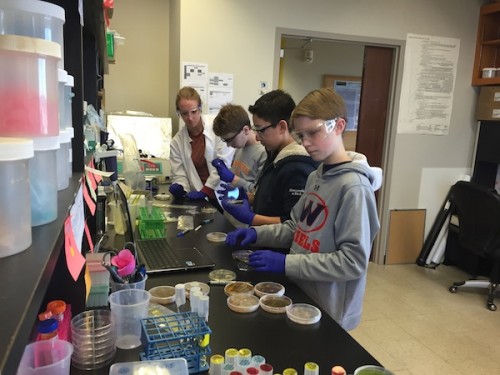
SSEP student researchers Jack Lathrop, Mauricio Sanchez, and Alex Hoffman are swabbing the bacteria Staph. Epidermidis onto agar plates to test how different antibiotics affect the growth.
Proposal Summary:
Bacterial conjunctivitis is a common infection and can affect astronauts during space travel. As space travel progresses, bacterial conjunctivitis could become a problem. We hope to address this problem by finding out if bacterial conjunctivitis will be affected by a normal antibiotic treatment. By doing this experiment, we hope to better understand the growth and treatment of bacterial conjunctivitis. Understanding the growth and treatment will not only allow us to effectively treat future infections, but will have implications of treating other bacterial infections in space as well.
HONORABLE MENTION FINALISTS:
Sea Monkeys to the Rescue
Grade 6, Halls Middle School, Knox County Schools
Co-Principal Investigators: Reagan Frye, Summer Keck
Collaborator: Rehtaeh Sutton
Teacher Facilitator: Jennifer Tidwell
Proposal Summary:
We would like to send Brine Shrimp, most commonly known as Sea Monkeys into microgravity
to understand how the lack of gravity affects the development of Sea-Monkeys. Sea-Monkeys
are a group of crustaceans that undergo cryptobiosis and are sold in hatching kits as novelty
aquarium pets. Sea-Monkeys should be sent into microgravity because they are extremophiles
and can help us understand if life exists elsewhere in the universe. For example, the recent
discovery of water, with high sodium content on our neighboring planet Mars could provide an
extension to this experiment if Brine Shrimp can develop adequately in microgravity. They
could be sent as an experiment to live in this or other extreme conditions to test if life could exist
in other locations in our solar system.
Analyzing the Affect of Microgravity on Germination of Squash Seeds
Grade 6, Halls Middle School, Knox County Schools
Co-Principal Investigators: Alyssa Morgan, Riley Turpin
Collaborator: Rehtaeh Sutton
Teacher Facilitator: Jennifer Tidwell
Proposal Summary:
We want to see if the Yellow Crookneck Squash, which is a type of Curcurbita Pepo (Summer
Squash) will germinate in microgravity. The reason for us wanting to conduct this experiment is to see if the seed does germinate in what is seemingly no gravity, then the astronauts stationed at the International Space Station could grow Yellow Crookneck Squashes and have another food source that is not dried and doesn’t contain chemicals. It would be an additional fresh and healthy alternative for astronauts.
17. Bullard, Texas
Jump to Bullard’s Community Profile
SELECTED FOR FLIGHT:
Microgravity’s Effects on Solanum tuberosum Resistance to Phytophthora
infestans
Grade 9, Bullard High School, Bullard Independent School District
Co-Principal Investigators: Emma Rhyne, Valerie Vierkant
Co-Investigators: Emmalie Ellis, Raelee Walker
Teacher Facilitator: Alaina Cannon
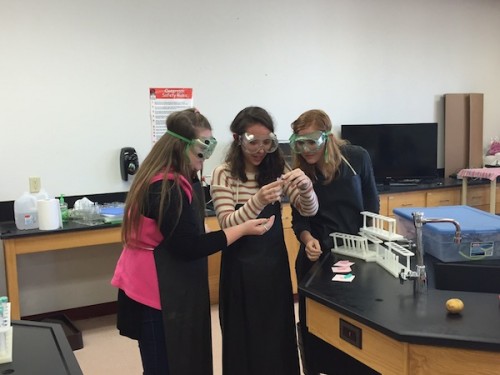
Emma Rhyne, Valerie Vierkant, and Emmalie Ellis. a team of 9th grade student researchers practicing protocols for prepping their experiment for spaceflight. (Not pictured Raelee Walker)
Proposal Summary:
Phytophthora infestans (Potato Blight) is a fungus-like protist that has caused many crop failures throughout the world, including the historical Great Potato Famine in Ireland . This protist invades the leaves and spreads to the tubers, killing the plant within days. Unless quickly disposed of, the infected plant will spread the disease throughout an entire field. Potato Blight cannot be killed, but varieties of potatoes have been discovered that are naturally resistant to the protist. The primary goal of this experiment is to determine how microgravity affects Solanum tuberosum resistance to Phytopthora infestans. Considering the potential need for future crops in space, it is important to expand our knowledge on microgravity farming. Little is known about the effect of microgravity on Solanum tuberosum,and even less is known about blight-resistant varieties. In this experiment, a sample of a blight-resistant Solanum tuberosum will be exposed to P. infestans aboard the International Space Station (ISS) and compared to our control, which will be conducted on Earth in normal gravity. Previous experiments have shown that members of the family Phytopthora demonstrate increased virulence in microgravity. The secondary goal of this experiment is to investigate how naturally blight-resistant varieties of S. tuberosum protect themselves from infection. This experiment will provide further insight to the poorly understood resistance mechanisms of certain varieties of S. tuberosum. We believe this experiment’s results will show the blight-resistant potato is more susceptible to P. infestans in microgravity as compared to normal gravity conditions.
HONORABLE MENTION FINALISTS:
Effects of E. coli on Sharkskin Surface in Microgravity
Grade 11, Bullard High School, Bullard Independent School District
Co-Principal Investigators: Matthew Bradley, Ashley Kethan
Co-Investigators: Alyssa Fowler, Elise Humphries, Trevor Johnson
Teacher Facilitator: Carl Logan
Proposal Summary:
Our experiment is attempting to observe how bacteria spreads under the effects of microgravity,
while on a surface similar to that of a shark’s skin. It is believed that by conducting this
experiment, the risk of the spread of bacteria in microgravity will be reduced, where astronauts’
immune system function is substantially lowered. A common bacteria that has an easy time spreading will be used, so it was decided that a strain of Escherichia coli, or better known as E. coli bacteria, would be best. The specific strain being observed is Escherichia coli 04-3529 (Migula) Castellani and Chalmers (ATCC® BAA-2649™). There will be a dormant form of the bacteria, and it will be activated so that it has the ability to spread. The bacteria will then be returned to its dormant state so its growth, before returned to Earth, is stopped. Upon return, the bacteria will be studied under a microscope to determine how the bacteria spread in microgravity. The surface used will be acquired from Sharklet Technologies. This surface is modeled to replicate a shark’s skin. Shark skin is known for prohibiting the growth of bacteria, so it will be ideal to use in our experiment. A ground experiment will also be conducted here on earth. The results from both of the experiments (the one on ISS and the one on earth) will help to determine whether or not shark skin surfaces are as effective in microgravity as they are here on the earth.
The Dissolving of Kidney Stones in Microgravity
Grade 11, Bullard High School, Bullard Independent School District
Principal Investigator: Jake Timme
Co-Investigators: Wes Carter, Hunter Granske, Tucker Pine
Teacher Facilitator: Carl Logan
Proposal Summary:
Many health issues can arise when one is in space for an extended period of time. Our
bodies are not made to live in a microgravity environment. Kidney stones are one of the many
effects space has on the body. Kidney stones are hard crystals that develop in the kidneys, and
they can cause tremendous amounts of pain and discomfort to the people that are in space the
same way they affect people here on Earth. Being able to dissolve the stones while in the
extremes of microgravity is an important aspect in long term space stay. We plan to make
synthetic kidney stones on earth, then send them into microgravity to test how they dissolve,
while conducting the same experiment simultaneously here on Earth. The results of this
experiment will give us a better idea on how to treat this health issue in microgravity.
18. Burleson, Texas
Jump to Burleson’s Community Profile
SELECTED FOR FLIGHT:
Kidney Stone Conundrum
Grade 5, The Academy at Nola Dunn, Burleson Independent School District
Co-Principal Investigators: Hannah Greenhill, Caleb Quisenberry, Cooper Williams
Teacher Facilitator: Riki Bunch-Pettigrew
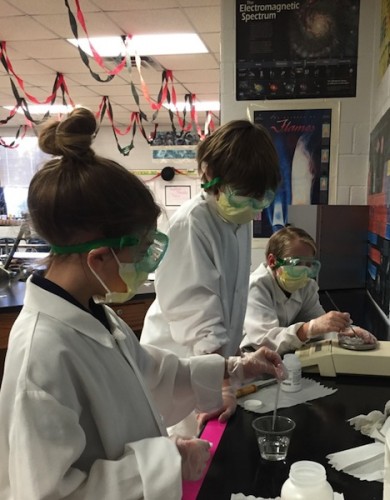
Academy at Nola Dunn students prepare to “grow” kidney stones in order to fine tune their experiment for flight.
Proposal Summary:
We propose to answer the question: Does microgravity have an effect on the disintegration of kidney stones (nephrolithiasis) in chanca piedra (phyllanthus niruri)? This information will let us know if chanca piedra will help astronauts with their frequent kidney stone issue. If they do not dissolve in microgravity, we will have to find an alternative solution. On Earth kidney stones are painful and stress causing, but with the frequent number in space they waste important time they could be using to do their jobs. They spend nine hours of their day researching and working on their projects, eight hours sleeping, and about an hour to have a meal because they have to heat the food, catch it, then eat it. Also, exercising two hours a day helps astronauts prevent bone and muscle loss. In our test we will simulate chanca piedra dissolving kidney stones in the human body. We want to prevent kidney stones for astronauts. We will put two kidney stones in volume one, volume two will have chanca piedra, and volume three will be filled with formalin. We will test this on Earth and in space then compare how much they dissolved. The result of this experiment might reduce the amount of time the astronauts deal with kidney stones. It will let us know if the astronauts will still have to go through all the pain as well. If they did not pass kidney stones so often they could be solving problems to help them live in space.
HONORABLE MENTION FINALISTS:
What are the Effects of Amoxicillin Fighting Against E. Coli in a Microgravity
Environment?
Grade 6, Kerr Middle School, Burleson Independent School District
Principal Investigator: Delaney Storey
Co-Investigators: Trinity Conard, Karis Knifley, Bailey Lasater
Teacher Facilitator: Lana Sather
Proposal Summary:
We propose to answer the question of what Escherichia Coli will do when exposed to
amoxicillin. Our team is looking forward to finding out if amoxicillin will successfully fight E.
Coli. We believe that the amoxicillin will fight Escherichia Coli better due to less gravity.
Amoxicillin is an important material as it is used to fight multiple bacterium such as salmonella,
ear infections, E. Coli, and some strains of strep throat. It is important to study what amoxicillin
will do to Escherichia Coli in space because if one astronaut gets bacterium in their system we
will know to use amoxicillin. We are dreaming big and hopefully one day there will be space
colonies with hospitals and varieties of different medication including amoxicillin. Our research
has shown that E. Coli is effectively treated with amoxicillin in regular Earth gravity. We plan to use a Type 2 FME with one clamp containing live E. Coli on one side and on the other amoxicillin. Once it reaches the ISS the amoxicillin will be introduced to the live E. Coli.
The Effect of Radiation on DNA in Microgravity
Grade 6, Hughes Middle School, Burleson Independent School District
Co-Principal Investigators: Belle Ann Davis-Hernandez, Emma Dustin, Emma Fritz, Presley Galland
Teacher Facilitator: Doug Cline
Proposal Summary:
We, as a group, want to see the effects of radiation on fixed pig blood cells. From what we have
learned, we think that when an astronaut is up in space for a long time with high radiation levels
that their DNA methylation process is altered so when an astronaut comes back down to earth
they are more likely to get different types of cancer. Also, to get certain genes turned on and off
means your expressed DNA will be changed. The astronauts offspring could possibly have the
same genetic changes as the astronauts have, they most likely will have a higher risk of getting
cancer just like their parent because the DNA will have the possibility of being passed on. This
type of epigentics is what our group is interested in doing. For this experiment we will be using an FME type 1 tube that uses no clamps.Volume 1 includes blood cells that are fixed in formalin. We are using the whole 9.4 ml of space in the tube for volume one. Our hypothesis is if the pigs blood is exposed to high radiation levels then the epigenetics will be altered through the DNA methylation process. Dr.Bobby LaRue will be testing the pig blood cells after the cells are returned from ISS they will be the at the University of North Texas.
19. Houston, Texas
Jump to Houston’s Community Profile
SELECTED FOR FLIGHT:
pGLO Plasmid Transfer in Escherichia coli as a Means to Track Antibiotic Resistance in Microgravity
Grade 11, Cesar E. Chavez High School, Houston Independent School District
Co-Principal Investigators: Esmeralda Cervantes, Ashley Olvera
Co-Investigators: Omar Compos, Esmeralda Pantoja
Teacher Facilitator: Dr. Jason Busby
Proposal Summary:
It has been proven that bacteria grow and interact much differently in space. In the past, NASA sent disease causing bacteria into space to observe its growth. However, studies are very limited in the area of bacteria transferring genes or plasmids for antibiotic resistance in a microgravity environment. The purpose of this study is to explore this area via the transfer of the pGLO plasmid carrying a gene for ampicillin resistance among colonies of Escherichia coli. Bacterial growth and antibiotic resistance transfer will be measured in an FME Type 1 modified into a common bacterial slant. Growth will be observed and measured on a periodic basis while the sample remains in orbit. The pGLO plasmid is being used due to its nature of glowing under a UV light source making observation of transfer easily observable with a small handheld UV light and the human eye. Possible implications for this experiment could lead to modification of treatment for astronauts on missions; and possibly before missions to condition the immune system, based on how the bacteria interact in a microgravity environment.
HONORABLE MENTION FINALISTS:
Regeneration of a Sea Cucumber
Grade 11, Cesar E. Chavez High School, Houston Independent School District
Co-Principal Investigators: Juan Calderon, Brandon Chacon, Jonathan Gutierrez, Luis Jasso, Moises Trevino
Teacher Facilitator: Anastasia Martynenko
Proposal Summary:
Our project involves studying the process of regeneration. To do so we will be sending a Sea
Cucumbers called Euapta lappa up into ISS. A sea cucumber is an animal similar to a slug that
when wounded or cut can regenerate its body parts. It is this specific process in which the sea
cucumber is regenerating its body parts that we wish to analyze in order to understand more of
what aids the process, if there are any defects, and how the skin and body parts are reconstructed. In order to get the sea cucumber into space, we will be sending the Sea Cucumber using the Type 3 mini lab with one clamp blocking the fixative and the other so that the sea cucumber and its water with algae be on one side.
The Effects of Microgravity on the Preservation Ability of Sodium Silicate
Grades 11-12, Cesar E. Chavez High School, Houston Independent School District
Co-Principal Investigators: Daniel Banda, Cesar Cruz, Yasmine Vasquez
Teacher Facilitator: Anastasia Martynenko
Proposal Summary:
Sodium Silicate was first observed by Jean Baptist van Helmont, circa 1640 and from its
conception it had a lot of uses. Liquid Sodium Silicate, (aka water glass) has been used to
preserve organic food such as eggs here on Earth similarly to vinegar with pickles; and Solid
Sodium Silicate can also be mixed with water in order to create a gel-like substance that can
create a seal for broken car parts related to the engine or the substance can be placed over a
broken pipe in order to stop a liquid from leaking which makes it a good and quick repair
material to extend the life of pieces. So you can say that Sodium Silicate has many uses for us
here on Earth, therefor Sodium Silicate is an important human made substance as a quick fix or
as a preservative. We wanted to be test Sodium Silicate’s ability to preserve eggs but due to the limitation of the FEM tube width we are going to compromise and use a semi-permeable substitute: a blueberry. Therefore our question is: “What affects does microgravity have on Sodium Silicate’s ability to preserve food stuff like blueberry?” If our hypothesis is correct, the Sodium silicate should keep out the moisture and decrease the rate of decay and extend the berries lifespan. In translation, the results should be similar if we used an egg.
20. McAllen, Texas
Jump to McAllen’s Community Profile
SELECTED FOR FLIGHT:
The Effects of the Perchlorate Ion in Simulated Martian Soil on Solanum lycopersicum Seed Germination in Microgravity
Grade 11, IB at Lamar Academy, McAllen Independent School District
Co-Principal Investigators: Sabrina Benitez, Sofia Escobar, Juan Pablo Flanagan
Advisors: Marc Braden, Dr. Anxiu Kuang, Dr. Michael Wayne Persans
Teacher Facilitator: Laura Nikstad
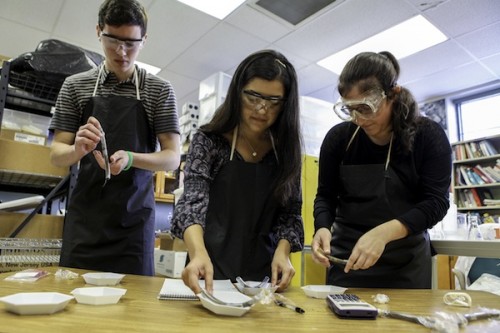
Juan Pablo, Sofia and Sabrina are conducting experiments to determine germination failure rates in tomato seeds to inform how they will pack their FME.
Proposal Summary:
One of NASA’s many current projects, and one the general public has been waiting for ever since we set foot on the Moon, is the human mission to Mars. The recent discovery of liquid water on Mars has increased our anticipation of this dream; however, along with water, it has been found that Martian soil contains high levels of magnesium perchlorate—a contaminant toxic to humans. Analyzing the results of the experiment will provide insight into the effects of perchlorate, combined with microgravity, and how these unfamiliar conditions will affect the
possibilities of ever establishing a sustainable colony on Mars. Future manned missions to Mars are in the works and questions about nutrition and sustainability must be answered. This experiment will give us a greater understanding of food growth on Mars, a planet with a significantly smaller amount of gravity than Earth. On the ISS, our Type 3 FME mini-lab will contain Martian simulated soil with tomato seeds and distilled water to catalyze the germination. After twelve days, a solution of 10% Neutral Buffered Formalin will be added to the soil in order to halt the growth and “freeze” any viable data so that we may be able to observe the tomato sprout on Earth and compare the results to the control groups in order to find how plants that have evolved to fit Earth’s conditions will grow and survive in conditions very different from our own.
HONORABLE MENTION FINALISTS:
Effects of Microgravity on Algae Growth
Grade 11, IB at Lamar Academy, McAllen Independent School District
Co-Principal Investigators: Roberto Iglesias, Nicolas Restrepo, Carlos Sanchez
Advisor: Dr. Hudson DeYoe
Teacher Facilitator: Laura Nikstad
Proposal Summary:
Algae are unique plants that are greatly used for research due to their variety of sizes and
types as well as their simplicity. The size of algae ranges from the microscopic level to large
seaweeds and can be grown using water that does not need to be perfectly clean. For our
experiment, we dealt with the green algae known as Scenedesmus in order to determine if the
growth of algae differs in microgravity compared to on Earth. We chose this algae due to the fact
that it can grow in the absence of light, surviving on glucose and water (Scenedesmus). A main
reason for why algae is so special is it has a large variety of uses that can benefit in space travel.
One major use for algae is as a fuel source; algae can be grown to produce biodiesel, bioethanol,
biobutanol, hydrogen, and biomass. These fuel sources may be used in the engine and may also
be used for electricity. Another purpose is as a food supplement since algae contains protein,
carbohydrates, and fatty acids useful for energy (Uses of Algae). Our procedure to observe the
change in the growth of Scenedesmus (if any) was to have the Scenedesmus be mixed with
nutrient filled water and stop its growth using Formalin (2 days). This allowed us to have a set
amount of time that the Scenedesmus would be growing for both in microgravity and on Earth.
The growth of the Scenedesmus would then be observed using a microscope.
The Effects of Microgravity on Gastric Acid Digestion of Proteins
Grade 11, IB at Lamar Academy, McAllen Independent School District
Co-Principal Investigators: Calvin N. Beck, Gabriela S. Pena, Alejandro M. Vail
Teacher Facilitator: Marc Braden
Proposal Summary:
In future human space travel, humans will have to live and adapt to microgravity, and
thus perform all of their vital functions, such as respiration and digestion, without the help of
gravity. On Earth, gravity does not only affect the human skeletal and muscular systems, but
affects all of the bodily functions, including the digestive system (The Body in Space). The
digestive system, primarily responsible for the transformation of food into energy, requires the
solid energy sources entered into the mouth to be broken down before translating them into
energy forms such as glucose, which cells use for respiration (Human Body Digestive System) .
Gastric acid — a strong, hydrochloric acid-based substance that includes the enzyme pepsin —
plays a significant role in digestion in humans, as the main solvent of proteins in the body
(Human Body Digestive System, My Favorite Protein: Pepsin). As humans embark on longer and longer missions, even the small effects on the astronauts will become more apparent, as they are forced to live in those unnatural conditions for even longer amounts of time. This brings up the question: “What are the effects of microgravity on gastric acid digestion of proteins in the human stomach?” The experiment will compare the length of proteins after a specified period of time in the experiment conducted on earth and in the International Space Station’s microgravity environment. Researchers can use the conclusions drawn from this experiment to help plan future missions to space and minimize the effects of microgravity on future astronauts.
21. Bellevue, Washington
Jump to Bellevue’s Community Profile
SELECTED FOR FLIGHT:
Arabidopsis thaliana Germination in Martian Soil Simulant
Grade 7, Open Window School, Northwest Association of Independent Schools
Co-Principal Investigators: Subi Lumala, Vivienne Rutherford, Catherine Whitmer
Teacher Facilitator: Brian Preston
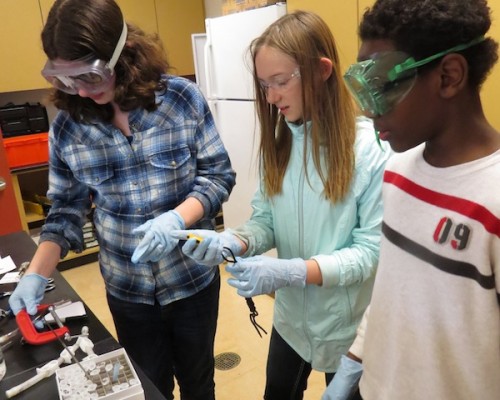
Open Window School seventh graders Vivienne Rutherford, Catherine Whitmer, and Subi Lumala conduct experimental trials with various numbers of Arabidopsis seeds in simulated Martian soil in order to optimize their FME flight configuration.
Proposal Summary:
Arabidopsis thaliana are plants that are highly experimented on. Our experiment is an investigation to see how they will grow in microgravity, and in a soil similar to that of the surface of Mars. Arabidopsis thaliana would be useful to have on Mars because of its experimental potential. It is not possible on Earth to simulate the lower gravity of Mars, so microgravity provides a test of lower-than-Earth gravity. The gravity on the ISS is almost 0 m/s2, the gravity on Mars is 3.8 m/s2 (Universe Today), and the gravity on Earth is 9.8 m/s2 (Universe Today). Gravity on the ISS allows us to test plant growth in an environment closer to the gravity on Mars.
HONORABLE MENTION FINALISTS:
Pectobacterium Hydrolyzation of Polysaccharides in Microgravity
Grade 4, Open Window School, Northwest Association of Independent Schools
Co-Principal Investigators: Nolan Daniels, Bess Hurlock, Sonja Larson, Nathan Wen
Teacher Facilitators: Erica Mahoney, Randy Hollinger
Proposal Summary:
Will plant tissue from Solanum tuberosum (potato) be more resistant to the plant pathogen bacteria Pectobacterium carotovorum in microgravity? Pectobacterium carotovorum makes plant cells lose their “grip” with each other by destroying the polysaccharides between the cell walls. We chose Pectobacterium carotovorum (formerly Erwinia carotovora) because it is
easy to keep for long periods of time and is important in learning about keeping plants healthy.
We saw in other research that NASA is interested in how plants grow in space, so we thought it
would be interesting to see how they fight disease. The particular strain of bacteria that we
propose to use has a plasma DNA GFP gene (green fluorescent protein) that allows us to study
the plant with an ultraviolet light when it returns to us to see where the bacteria decided to grow.
After contacting an expert (Dr. Amy Charkowski – University of Wisconsin Plant Pathology), we
decided not to use a carrot as we wanted to at first and instead to use a Solanum tuberosum as
our test subject because it will last long enough for the microgravity experiment. We are also
going to use highly sterile water to keep the Solanum tuberosum in good condition for our
experiment. We will use an FME 2 with one clamp so we can have the astronauts release the
Pectobacterium carotovorum into the Solanum tuberosum to see the effect. We believe that
without gravity, the Solanum tuberosum will be more resistant than our experiment on Earth.
Hydroponics Germination in Microgravity
Grade 5, Open Window School, Northwest Association of Independent Schools
Co-Principal Investigators: Ava Arabshahi, Claire O’Connor, Anika Thomas
Teacher Facilitator: Danalynn Coulon
Proposal Summary:
Our team aims to study whether hydroponic plant germination would work in microgravity because of the differences in pressure and gravity levels compared to earth. Hydroponics is growing plants without dirt, just with water and fertilizer. Plants growing on earth rely on a small amount of gravity to spread roots. We want to investigate if hydroponics will be able to germinate in microgravity and low-pressure conditions in space. In the proposed experiment, we plan to use alfalfa and medallion seeds, Rockwool cubes as the growing environment, and FloraGro as fertilizer. We have conducted two trials on earth, using basil and ryegrass seeds, cotton balls for the growing environment, and banana peels as a natural fertilizer (alfalfa seeds, medallion seeds, and Rockwool cubes were not available to us at the time of our trials). Our trial experiments demonstrated that both our basil and ryegrass seeds germinated successfully in about seven days. According to our research, alfalfa and medallion seeds also germinate in about six to seven days. This proposed experiment is important because its results can help astronauts harvest fresh food while in space. Both of these plants are edible and high in nutrients. Currently, astronauts have to eat dried foods, which, after a while, get boring. Also growing with dirt may be difficult because dirt weighs more than water. Water already exists on the ISS. The hydroponics technique may be applied to any type of seed, which can be very useful.

